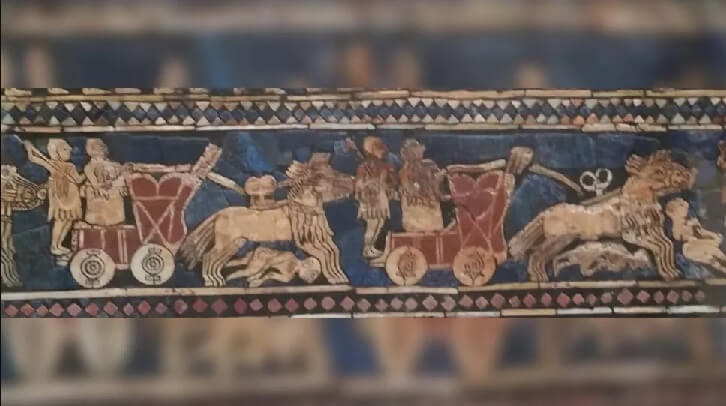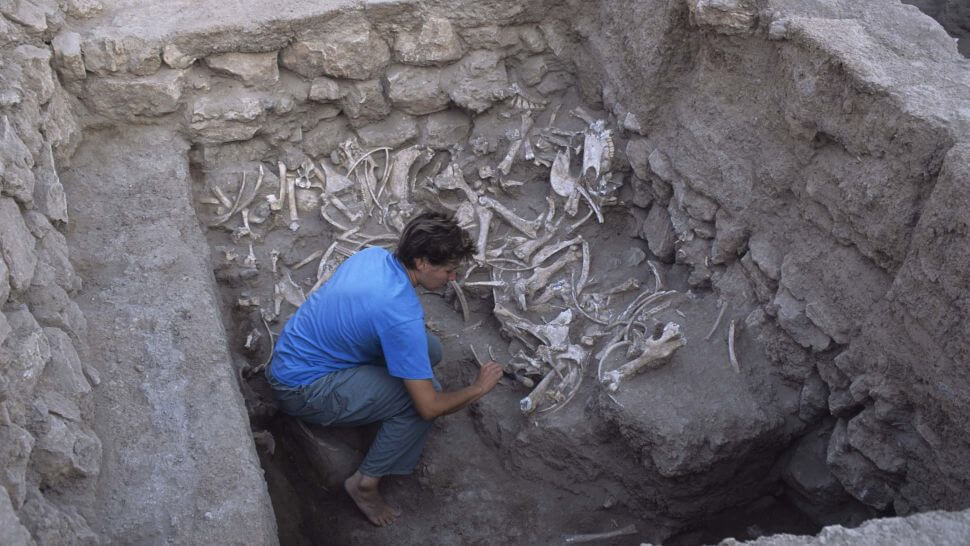
1st Bioengineered Hybrid Animals Discovered – In Ancient Mesopotamia
Skeletons of "kungas" discovered in a princely burial.
By: Tom Metcalfe | Live Science
Mesopotamians were using hybrids of domesticated donkeys and wild asses to pull their war wagons 4,500 years ago — at least 500 years before horses were bred for the purpose, a new study reveals.
The analysis of ancient DNA from animal bones unearthed in northern Syria resolves a long-standing question of just what type of animals were the “kungas” described in ancient sources as pulling war wagons.
“From the skeletons, we knew they were equids [horse-like animals], but they did not fit the measurements of donkeys and they did not fit the measurements of Syrian wild asses,” said study co-author Eva-Maria Geigl, a genomicist at the Institut Jacques Monod in Paris. “So they were somehow different, but it was not clear what the difference was.”
The new study shows, however, that kungas were strong, fast and yet sterile hybrids of a female domestic donkey and a male Syrian wild ass, or hemione — an equid species native to the region.
Ancient records mentioned kungas as highly prized and very expensive beasts, which could be explained by the rather difficult process of breeding them, Geigl said.
Because each kunga was sterile, like many hybrid animals such as mules, they had to be produced by mating a female domesticated donkey with a male wild ass, which had to be captured, she said.
That was an especially difficult task because wild asses could run faster than donkeys and even kungas, and were impossible to tame, she said.
“They really bio-engineered these hybrids,” Geigl told Live Science. “There were the earliest hybrids ever, as far as we know, and they had to do that each time for each kunga that was produced — so this explains why they were so valuable.”
Gigantic Aztec Temple Unearthed In Mexico City
War Donkeys

Kungas are mentioned in several ancient texts in cuneiform on clay tablets from Mesopotamia, and they are portrayed drawing four-wheeled war wagons on the famous “Standard of Ur,” a Sumerian mosaic from about 4,500 years ago that’s now on display at the British Museum in London.
Archaeologists had suspected that they were some sort of hybrid donkey, but they didn’t know the equid it was hybridized with, Geigl said.
Some experts thought Syrian wild asses were much too small — smaller than donkeys — to be bred to produce kungas, she said.

The species is now extinct, and the last Syrian wild ass — not much more than a meter (3 feet) tall — died in 1927 at the world’s oldest zoo, the Tiergarten Schönbrunn in Vienna in Austria; its remains are now preserved in that city’s natural history museum.
In the new study, the researchers compared the genome from the bones of the last Syrian wild ass from Vienna with the genome from the 11,000-year-old bones of a wild ass unearthed at the archaeological site of Göbekli Tepe, in what is now southeaster Turkey.
That comparison showed both animals were the same species, but the ancient wild ass was much larger, Geigl said. That suggested that the Syrian wild ass species had become much smaller in recent times than it had been in antiquity, probably due to environmental pressures such as hunting, she said.
Ancient Mesopotamia
Historians think that the Sumerians were the first to breed kungas from before 2500 B.C. — at least 500 years before the first domesticated horses were introduced from the steppe north of the Caucasus Mountains, according to a 2020 study in the journal Science Advances by many of the same researchers.
Ancient records show the successor states of the Sumerians — such as the Assyrians — continued to breed and sell kungas for centuries — and a carved stone panel from the Assyrian capital Nineveh, now in the British Museum, shows two men leading a wild ass they had captured.
The kunga bones for the latest study came from a princely burial complex at Tell Umm el-Marra in Northern Syria, which has been dated to around the early Bronze Age between 3000 B.C. and 2000 B.C.; the site is thought to be the ruins of the ancient city of Tuba mentioned in Egyptian inscriptions.
Study co-author Jill Weber, an archaeologist at theUniversity of Pennsylvania, excavated the bones about 10 years ago. Weber had proposed that the animals from Tell Umm el-Marra were kungas because their teeth had marks from bit harnesses and patterns of wear that showed they had been purposefully fed, rather than left to graze like regular donkeys, she said.
Kungas could run faster than horses, and so the practice of using them to pull war wagons probably continued after the introduction of domesticated horses into Mesopotamia, she said.
But eventually the last kungas died and no more were bred from donkeys and wild asses, probably because domesticated horses were easier to breed, Geigl said.
The new study was published Friday (Jan. 14) in the journal Science Advances.
* * *
NEXT UP!
Gobekli Tepe: The World’s First Temple?
Six miles from Urfa, an ancient city in southeastern Turkey, Klaus Schmidt has made one of the most startling archaeological discoveries of our time: massive carved stones about 11,000 years old, crafted and arranged by prehistoric people who had not yet developed metal tools or even pottery. The megaliths predate Stonehenge by some 6,000 years.
The place is called Gobekli Tepe, and Schmidt, a German archaeologist who has been working here more than a decade, is convinced it’s the site of the world’s oldest temple.
* * *
READ MORE: This Ancient Maya City Was Hidden In The Jungle For More Than 1,000 Years
More on Archaeology: Guanches: Ancient Mummies of The Canary Islands (Video)
Telegram: Stay connected and get the latest updates by following us on Telegram!
We’d love to hear from you! If you have a comment about this article or if you have a tip for a future Collective Spark Story please let us know below in the comment section.
